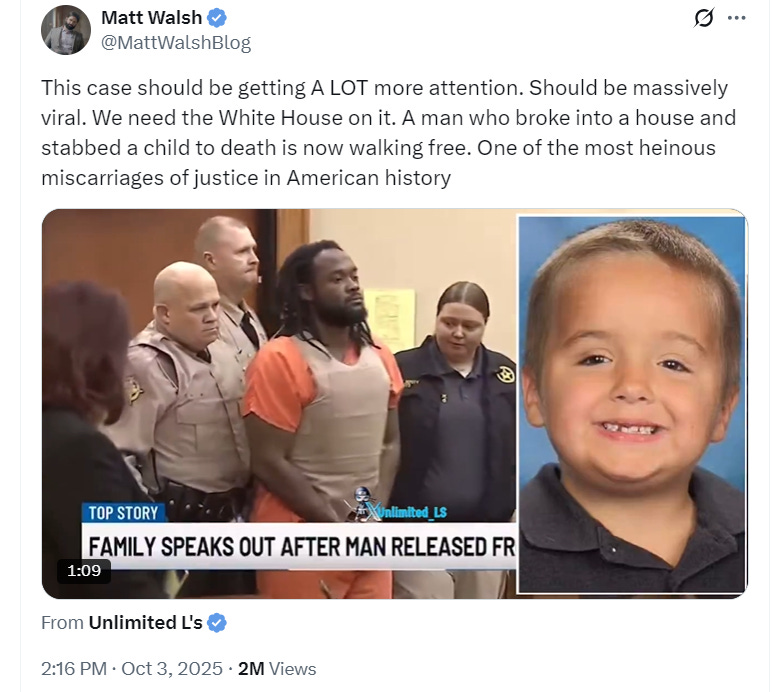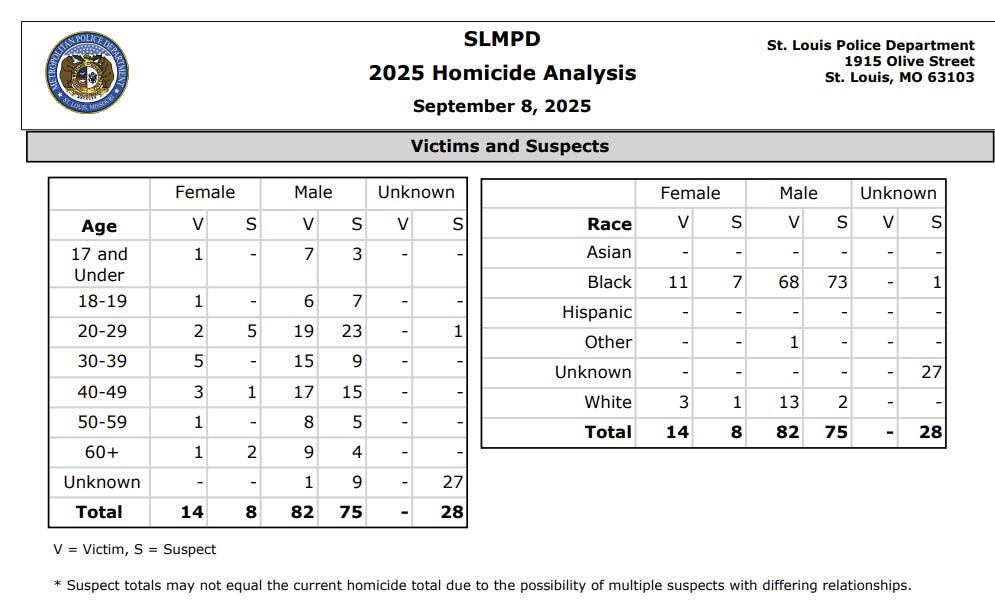RESENDING: On psychosis, cannabis, race, and violence
(NOTE TO READERS: THIS PIECE SEEMS TO HAVE BEEN CAUGHT IN THE SUBSTACK PUBLISHING ENGINE. NOT SURE WHAT HAPPENED, BUT I APOLOGIZE FOR THE MULTIPLE SENDS. IF YOU CHOOSE TO COMMENT, PLEASE DO SO ON THIS VERSION.)
Once again, the crime is awful.
On Dec. 7, 2015, Ronald Exantus broke into the Kentucky home of six-year-old Logan Tipton and stabbed Logan to death as he screamed. The killing was random. Exantus had never met Logan or his family before.
Now — not even a decade later — Exantus has been released from prison.
Exantus is black. Logan Tipton was white. Tipton’s family is furious. And conservative anger at black-on-white crime is boiling again, as it did in the horrific case of Iryna Zarutska, the Ukrainian refugee slashed to death in Charlotte in August.
—
(The truth, even when it’s hard to read.)
—
But hiding behind the racial element in this case is the crisis of cannabis psychosis and the violence it brings.
It is no exaggeration to say Exantus’s cannabis use may well have caused his crime — and that the prosecution’s failure to explain that fact properly led to a miscarriage of justice.
In 2015, Exantus was not a typical murder suspect.
He had no criminal history and had worked for a decade as a nurse in Indianapolis. As the Kentucky Supreme Court explained in 2020, “his coworkers and supervisors described him without exception as an exemplary, dependable, and trustworthy employee… he had no documented history of mental illness.”
But Exantus was smoking cannabis frequently. Just before killing Logan Tipton, he seems to have suffered a manic episode. He began sleeping and eating less, acting oddly at work, and “having crying spells,” according to a Kentucky Supreme Court ruling. On the day before he killed Tipton, he became incoherent at his church, and:
began pointing at people and saying they were police officers and investigators. Soon after that, he got on one knee and proposed to Lauren [his girlfriend] while sobbing hysterically...
But a few hours later, Exantus told Lauren:
he did not want to marry her or be with her. He also said that he was not going to hurt her, but he had to go.
Then he vanished.
He seems to have planned to drive to Florida. Instead, he wound up around 4 a.m. in Versailles, Kentucky, near Lexington. He saw a street sign for “Grey’s Street,” a sign that reminded him of the medical drama Grey’s Anatomy. Exantus later told police that remembering the show “made me think of knives for surgery.”
His eye fell upon the Tipton house. Its front door was unlocked. Exantus walked in, found a knife, and stabbed Logan to death — “reenacting surgery,” in his words.
—
(2 million views, and counting. The days of not talking about cases like this are over.)

—
Obviously, Exantus was not in his right mind when he killed Logan.
Whether he was legally insane is a different question. After the crime, Exantus was treated for his psychosis and restored to competency, so he could participate in his defense and his trial could move forward.
The case garnered local attention, and prosecutors said they would seek the death penalty. At Exantus’s 2018 trial, no one disputed he had stabbed Logan Tipton to death or attacked other members of the Tipton family. But defense lawyers argued that he was insane at the time, and called a psychologist who agreed.
In response, prosecutors claimed drugs — perhaps PCP1 or a “synthetic cannabinoid” such as K2 — explained Exantus’s psychotic break. Substance-induced psychosis cannot be used as an insanity defense, and a key question in many cases like this is whether psychosis is drug-induced or organic.
As the Lexington Herald-Leader, which extensively covered the case, succinctly explained:

—
Unfortunately for prosecutors, they could not prove Exantus had used synthetic drugs.
THC — the psychoactive compound in cannabis — was the only substance found in his system, in a form that did not show immediate use. And the cannabis police recovered from his car had not been adulterated with PCP or other drugs. So prosecutors could only speculate that he had used a “novel psychoactive compound” that would not appear on a toxicology screen.
Notably, Exantus was tried before a “death-qualified” jury, composed of people who had agreed in advance they would be willing be vote for the death penalty. Such juries are inherently conservative, and civil rights groups complain that they are more likely to return guilty verdicts.
Even so, jurors appeared to find the prosecution’s insistence Exantus had used a synthetic drug unconvincing. They returned an unusual verdict, finding him not guilty by reason of insanity on the murder charge for Logan’s killing but “guilty but mentally ill” on the lesser assault charges for stabbing other family members.
The decision infuriated Logan’s family and made little logical sense, since Exantus committed all the crimes simultaneously. It appears to be the jury’s effort to split the difference in the case, agreeing Exantus was mentally ill while still trying to impose some penalty.
The judge imposed the maximum sentence on the assault charges, 20 years. But with time off for good behavior, Exantus is now free.
—
In reality, Exantus’s case carries all the hallmarks of cannabis-induced psychosis: heavy cannabis use, a decline into bizarre behavior, and a shocking and violent crime, and then a rapid return to sanity once he stopped using. There is little chance he had schizophrenia, which develops earlier and is generally far too severe to give its sufferers a chance to work at a complex job such as nursing.
Why didn’t prosecutors explain all this to the jury? Why did they focus on drugs they couldn’t find instead of the drug they knew Exantus used — a drug that provably causes mania and psychosis? Had jurors understood Exantus’s cannabis use might be responsible for his actions, they would have been far more likely to convict him.
I don’t know. Some prosecutors even now are unaware of the scientific links between cannabis and psychosis — or fear that juries have been conditioned by years of pro-cannabis propaganda to reject them.
But for whatever reason, prosecutors gave the defense a clear path to save Exantus from a murder conviction, and the defense took it.
—
(Looking for the truth, from Covid to crime. Please help me find it.)
—
Unfortunately for Exantus, cultural and political attitudes towards crime are very different than they were a decade ago.
Cases like his — in which a black man commits violent crime against a white victim — now receive as much attention from the right as cases of police brutality against black people received from the left a decade ago. Logan Tipton’s father has already threatened vengeance against Exantus, an understandable if regrettable impulse.
At a time when racial tensions around crime are rising, we all would have been better off if prosecutors had managed to bring a better case in 2018.
As I wrote in Tell Your Children, and have written over and over since:
Cannabis causes psychosis.
Psychosis causes violence.
Sometimes it causes injustice too.
—
—
(If you missed last month’s piece about the killing of Iryna Zarutska:)
On black violence, woke lies, and right-wing rageAlex Berenson·Sep 9
You’ve seen the photo.
Read full story1The commonly used name for phencyclidine, a powerful synthetic compound sometimes called “angel dust.” PCP was developed as an anesthetic but withdrawn because it frequently causes psychosis.